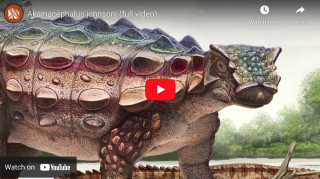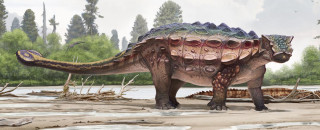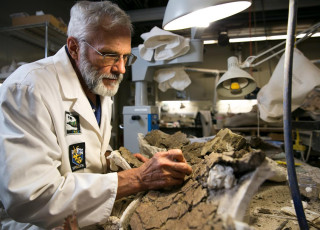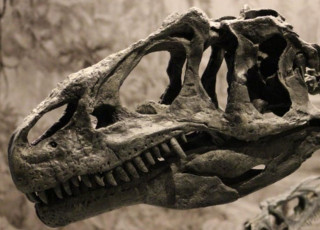Spiky-Headed Dinosaur a First for Utah
Akainacephalus johnsoni. Image © Andrey Atuchin/DMNS 2017
By Brian Switek
What’s covered in spikes and 76 million years old? The answer isn’t a prehistoric pincushion. It’s Akainacephalus johnsoni, the newest dinosaur to be named from Utah.
The scientific story of this singularly spiny dinosaur goes back to 2008. In that year BLM paleontologist Scott Richardson found a promising fossil site in the Kaiparowits Formation of Grand Staircase-Escalante National Monument. The Natural History Museum of Utah paleontology crew soon began excavations there, and what they found was a petrified bonanza.
The site, NHMU’s Chief Curator Randall Irmis says, was “really unusual” in that “it had bones from a number of different types of animals. And not only individual bones, but associated skeletons.” There was a skeleton of the duckbilled dinosaur Gryposaurus monumentensis - currently on display in the Past Worlds Gallery - a new species of pig-nosed turtle called Arvinachelys goldeni, and a as-yet unnamed new species of prehistoric caiman relative, for starters. But there was something else - the bones of a heavily-armored, herbivorous dinosaur no one had ever found before.
Prepped in the fossil lab by volunteer expert Randy Johnson, the dinosaur turned out to be a major find. Jelle Wiersma, who studied and described Akainacephalus for his master’s thesis with Irmis, says “It’s a really cool specimen, the most complete ankylosaurid dinosaur recorded from Utah to date.”

“We have a large portion of the skeleton, including nearly all of the skull, a lot of the vertebral column, the pelvis, as well as the limbs and ribs, and a lot of the armor, as well,” Irmis says, noting “It’s pretty rare to find so much of the skeleton in one place.” All that is enough to not only identify the dinosaur as new to science - its species name honoring the hundreds of hours of work Johnson put into its preparation - but also pin Akainacephalus as the first member of its lineage to ever be discovered in the beehive state. “It’s completely different from any other ankylosaurids that we’ve actually seen,” Wiersma says, and, as Irmis adds, “We are the lucky paleontologists to be the first to recognize this new species.”
In technical terms, Akainacephalus is a ankylosaurid. This is the specific subset of armored dinosaurs that included species with formidable tail clubs, like Ankylosaurus itself. None had ever been found in Utah before, meaning that Akainacephalus helps fill in the bigger picture of how these dinosaurs evolved and spread around the world.
The old bones connect two continents. At 76 million years old, Akainacephalus is one of the oldest ankylosaurids yet found in North America. And along with another dinosaur recently found in New Mexico, Irmis notes, Akainacephalus is more closely related to ankylosaurids found in Asia than other species from North America. This is a hint that ankylosaurids crossed an ancient land bridge from Asia to North America prior to 76 million years ago, one of several interchanges where ankylosaurids wandered from ancient Mongolia and China to western North America.
The most striking aspect of Akainacephalus, though, is its armor. “Its head is particularly spiky,” Irmis said, so much so that its name literally means “spiky head.” But that’s hardly all. From its snout to the end of its mace-like tail, this dinosaur was covered in osteoderms that not only offered protection but also would have given Akainacephalus a flashy, ornate appearance. As far as dinosaur fashion goes, you can certainly say Akainacephalus was one prickly customer.
Watch a video about the discovery of Akainacephalus johnsoni here.
Brian Switek is the author of My Beloved Brontosaurus, Prehistoric Predators, and a science writer for the Natural History Museum of Utah, a part of the University of Utah in Salt Lake City. Our mission is to illuminate the natural world and the place of humans within it. In addition to housing outstanding exhibits for the public, NHMU is a research museum. Learn more.



